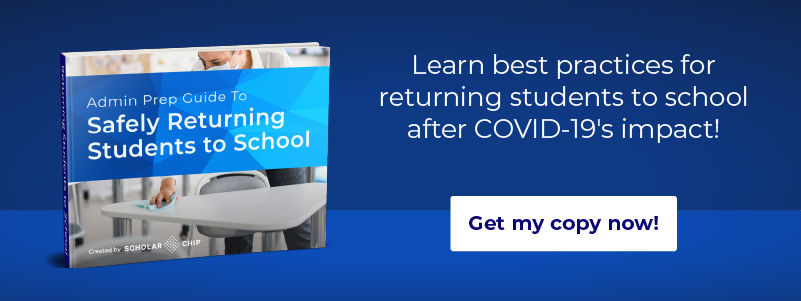Stay-in-place orders and school shutdowns were quickly implemented in the early days of the COVID-19 emergency. School administrators were challenged to execute their emergency plans even as they focused on providing educational continuity to students.
Schools are now facing a new challenge: how to keep the students and their communities safe with the ever-growing prospect of a second wave. With no vaccine and spikes in infections in some states, the threat of the virus is still very real.
Guidelines designed to help schools minimize exposure have been released. Still, there remains a high likelihood that you will see cases of coronavirus within your schools.
Best practices to monitor student infections within your school’s population, like minimizing cohort sizes and keeping track of attendance data, will help you understand the illness’s spread and contain it. It will also give you the information you need to keep students, staff, parents, and the community up to date.
Protecting students from the spread of infection and preventing an outbreak should be the goals of your safety plans. Following the best practices to monitor student infections will give you the best chance to meet those goals.
Minimize the Size of Groups
Cohorting, or creating small groups of students who learn together, is one strategy for monitoring infection. Minimizing class sizes limits the contact that a given group has with others in the school.
In their guidelines for restarting schools, the Centers for Disease Control and Prevention (CDC) recommends smaller class sizes to help monitor and contain the virus. International school officials are also recommending cohorts for infection containment.
Creating these groups of students and having them go throughout their day together, with little contact with other students, allows staff to rapidly identify and contain an outbreak. This is because it will be possible to quarantine just that small group instead of shutting down the entire school.
Smaller groups also simplify symptom checking and wellness monitoring by teachers. It’s easier to spot a student who falls ill in a smaller group, even if they don’t report being sick.
Request Families to Voluntarily Report Illnesses
Another best practice to monitor student infections is to request that all families self-report symptoms and positive COVID-19 tests.
That said, your school must respect a family’s privacy. Any reporting of health concerns must be voluntary, to ensure that you are adhering to applicable laws, and that information must be kept confidential.
Ideally, this should be addressed at the district level. A system-wide policy statement regarding reporting and outlining privacy practices and notification policies will ensure consistent application of the rules and make families feel more secure in sharing their information.
Consider Contact Tracing
To support notification and isolation procedures, your school should consider adding contact tracing to your school’s community. The good news is that contact tracing doesn’t require extensive epidemiology skills. It can be conducted by the person who has been selected within your school to be the infection contact, likely your school nurse.
When a student or family self-identifies as a positive coronavirus case, schools should know the contacts the student makes regularly throughout their day, as well as any interactions with staff or students outside of their cohort. Technology companies have released contact tracing software to make the process easier. Additionally, John Hopkins is offering a free online course in contact tracing.
A school’s attendance software can assist as well. If your system identifies a student’s movements throughout the day, including which doors they’ve used, buses they’ve taken, etc., this data can inform contact tracing efforts.
Keep Track of Attendance
Of course, not all families will self-report illnesses related to COVID-19. Schools should still have the ability to keep and track attendance records.
To help monitor student infections, a school must keep accurate data. Automated attendance software relieves the burden from administrative staff in collating the data and ensures that the information is secure, accessible, and reportable. It also provides schools with an overview of a student’s activities within the school during the time that they were likely contagious.
Keep Track of Visitors
Many schools already track and identify visitors as part of a broader safety plan. However, when it comes to COVID-19 infection tracking, schools should consider collecting additional information.
Consider adding a questionnaire that visitors must complete upon entering the campus. It should include their contact information so they can be notified if an outbreak occurs. You may also want to add fever checks. During the period that you are still concerned with the spread of infection, minimize visitor access and limit or remove volunteering in classrooms.
A visitor management system can help you keep track of outsiders who come to the school. It will let you keep clear and accurate records of visitors, when their visit occurred, their reason for visiting, and what access they were allowed.
Schools will have a host of challenges when school resumes. New policies, procedures, and information will merely be a portion of the “new normal” that students, staff, and parents will need to adapt to. Monitoring and tracking infections within your school will be one facet of your action plan to keep students safe. Following best practices for keeping track of infections within the school’s population will help you identify and quickly contain hotspots and at-risk populations and take the appropriate steps to keep everyone healthy.
ScholarChip offers unique holistic school safety services based on CDC guidelines to help schools reopen amidst growing health concerns. Through our advanced technology, built and designed for the K-12 environment, schools can identify risk and mitigate the spread of infection. Our solution includes fever screening, visitor questionnaires, symptom and vaccine tracking, in-school contact tracing, alerts, and notifications. Learn more about our advanced COVID-19 solutions or request a reopening strategy session today!


